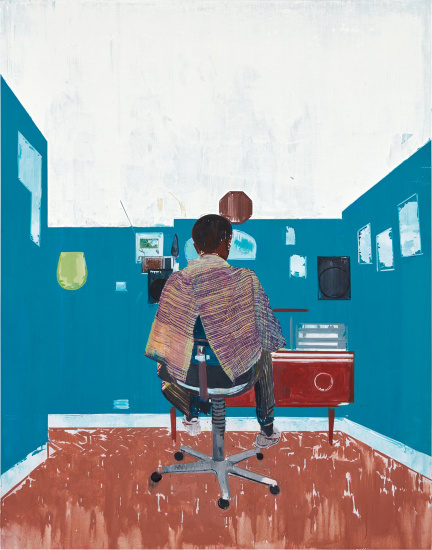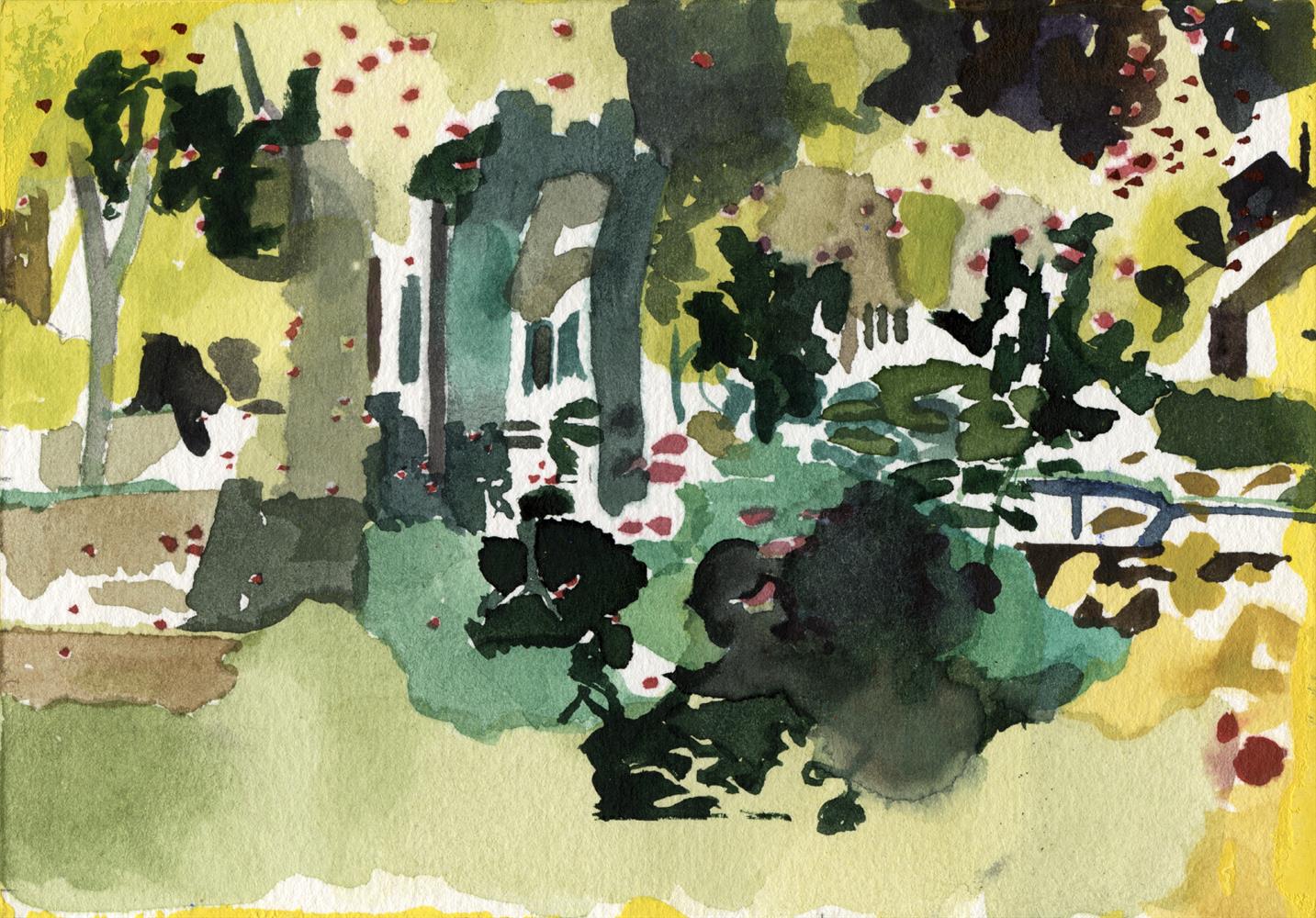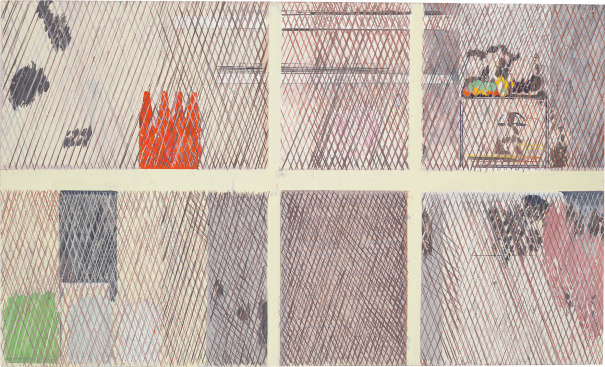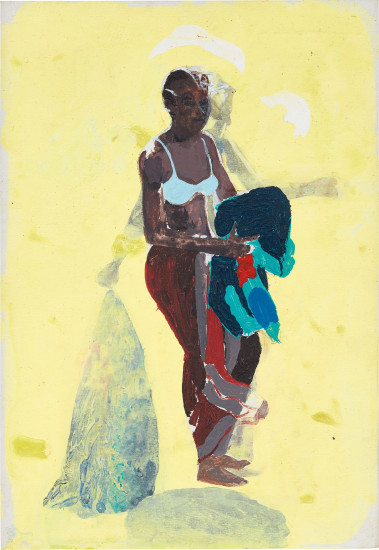Property from a Private Collection Hurvin Anderson Follow Untitled (Park Scene) oil on canvas 150.1 x 237.9 cm (59 1/8 x 93 5/8 in.) Painted in 2000.
Provenance Thomas Dane Gallery, London Private Collection, Los Angeles Acquired from the above by the present owner Catalogue Essay Inviting the viewer into a landscape of personal memory and diaphanous washes, the muted vibrancy of the present composition is exemplary of 2017 Turner Prize nominee Hurvin Anderson’s painterly dexterity. Painted in 2000, during the early stages of the artist’s career, Untitled (Park Scene) draws the viewer in to the artist’s wistful realm of perception and altered perspective. Through the artist’s nostalgic vision and in dialogue with the masters of art history, the present work expertly negotiates the boundary between figuration and abstraction. Internationally celebrated for his insightful portrayal of British and Caribbean culture, Anderson’s canvases expertly test the constraints of art history. A figment of the artist’s childhood recollections, the enigmatic landscape in Untitled (Park Scene) is inspired by Handsworth Park, a communal park in the artist’s native Birmingham. Throughout his oeuvre Anderson, born to Jamaican parents who emigrated to England after the Second World War, investigates his ‘own relationship to the Caribbean’ (‘Hurvin Anderson, in conversation with Thelma Golden’, Art Now: Hurvin Anderson Peter’s Series . 2007 – 2009, exh. cat., Tate Britain, London, 2009, n.p.). A scene from his youth, the textural and layered depiction of the artist’s neighbourhood park, reflects the emotion of the artist’s nostalgic vision. Presenting a deliberately indefinite landscape of an unidentifiable location, Anderson leaves the onlooker pondering the setting of the scene. Whilst inspired by Birmingham, the park could be a vista drawn from the memory of the artist's Caribbean heritage. Inspired by his upbringing, and the sense of community within which he lived, Anderson’s oeuvre pays homage to his cultural and political forbearers whilst simultaneously contributing to discourse about the legacy of painting. Reminiscing about the work, the artist recalls the end of football practice and the need to get ready to go. Caught in the space between endings and beginnings, the composition presents the viewer with several figures in the park. Juxtaposing the muted greens with the synthetic hues of football kit, Anderson evokes a figment of his imagination, drawn from distant memory. Figures, often indistinct, feature in many of Anderson’s works. Often not fully materialising, the suggestion of figuration is almost always present: ‘Ninety per cent of them,’ he says, ‘are meant to have a figure somewhere’ (Hurvin Anderson quoted in Alice Spawls, ‘It’s only in painting that you can do everything you want’, Apollo , 17 September 2016). Exemplary of Anderson’s earlier work, in Untitled (Park Scene) areas of wash and impasto reveal the layered nature of the painterly composition. As his later works introduce artificial cage-like grids and separation devices, the present composition utilises nature and fields of colour to distance the viewer from the scene. Creating the illusion of surface damage or disintegration of image, Anderson’s nostalgic painting is an illusory and reflective field. Within Untitled (Park Scene) , the environment conjured by Anderson intrepidly recalls the distinct art historical genre of figurative landscape mastered by pointillist pioneer Georges Seurat Mirroring the scenes within Seurat’s Bathers at Asinières , Untitled (Park Scene) marries Anderson’s unique geography and identity, with the tradition of early twentieth century painting. The late-nineteenth-century bourgeois scene presented in Seurat’s masterpiece is, here, reimagined and replaced with Anderson’s own recollection of community football practice and childhood memory. Reworking the traditional pictorial syntax of post-impressionist masters, Anderson undercuts the European representation of the bourgeoisie at a time when the Caribbean was heavily dominated by colonial rule. Reconciling personal memory, historical
Property from a Private Collection Hurvin Anderson Follow Untitled (Park Scene) oil on canvas 150.1 x 237.9 cm (59 1/8 x 93 5/8 in.) Painted in 2000.
Provenance Thomas Dane Gallery, London Private Collection, Los Angeles Acquired from the above by the present owner Catalogue Essay Inviting the viewer into a landscape of personal memory and diaphanous washes, the muted vibrancy of the present composition is exemplary of 2017 Turner Prize nominee Hurvin Anderson’s painterly dexterity. Painted in 2000, during the early stages of the artist’s career, Untitled (Park Scene) draws the viewer in to the artist’s wistful realm of perception and altered perspective. Through the artist’s nostalgic vision and in dialogue with the masters of art history, the present work expertly negotiates the boundary between figuration and abstraction. Internationally celebrated for his insightful portrayal of British and Caribbean culture, Anderson’s canvases expertly test the constraints of art history. A figment of the artist’s childhood recollections, the enigmatic landscape in Untitled (Park Scene) is inspired by Handsworth Park, a communal park in the artist’s native Birmingham. Throughout his oeuvre Anderson, born to Jamaican parents who emigrated to England after the Second World War, investigates his ‘own relationship to the Caribbean’ (‘Hurvin Anderson, in conversation with Thelma Golden’, Art Now: Hurvin Anderson Peter’s Series . 2007 – 2009, exh. cat., Tate Britain, London, 2009, n.p.). A scene from his youth, the textural and layered depiction of the artist’s neighbourhood park, reflects the emotion of the artist’s nostalgic vision. Presenting a deliberately indefinite landscape of an unidentifiable location, Anderson leaves the onlooker pondering the setting of the scene. Whilst inspired by Birmingham, the park could be a vista drawn from the memory of the artist's Caribbean heritage. Inspired by his upbringing, and the sense of community within which he lived, Anderson’s oeuvre pays homage to his cultural and political forbearers whilst simultaneously contributing to discourse about the legacy of painting. Reminiscing about the work, the artist recalls the end of football practice and the need to get ready to go. Caught in the space between endings and beginnings, the composition presents the viewer with several figures in the park. Juxtaposing the muted greens with the synthetic hues of football kit, Anderson evokes a figment of his imagination, drawn from distant memory. Figures, often indistinct, feature in many of Anderson’s works. Often not fully materialising, the suggestion of figuration is almost always present: ‘Ninety per cent of them,’ he says, ‘are meant to have a figure somewhere’ (Hurvin Anderson quoted in Alice Spawls, ‘It’s only in painting that you can do everything you want’, Apollo , 17 September 2016). Exemplary of Anderson’s earlier work, in Untitled (Park Scene) areas of wash and impasto reveal the layered nature of the painterly composition. As his later works introduce artificial cage-like grids and separation devices, the present composition utilises nature and fields of colour to distance the viewer from the scene. Creating the illusion of surface damage or disintegration of image, Anderson’s nostalgic painting is an illusory and reflective field. Within Untitled (Park Scene) , the environment conjured by Anderson intrepidly recalls the distinct art historical genre of figurative landscape mastered by pointillist pioneer Georges Seurat Mirroring the scenes within Seurat’s Bathers at Asinières , Untitled (Park Scene) marries Anderson’s unique geography and identity, with the tradition of early twentieth century painting. The late-nineteenth-century bourgeois scene presented in Seurat’s masterpiece is, here, reimagined and replaced with Anderson’s own recollection of community football practice and childhood memory. Reworking the traditional pictorial syntax of post-impressionist masters, Anderson undercuts the European representation of the bourgeoisie at a time when the Caribbean was heavily dominated by colonial rule. Reconciling personal memory, historical





.jpg)
.jpg)
.jpg)


.jpg)



.jpg)
Try LotSearch and its premium features for 7 days - without any costs!
Be notified automatically about new items in upcoming auctions.
Create an alert